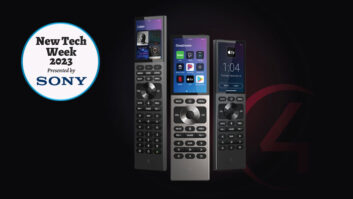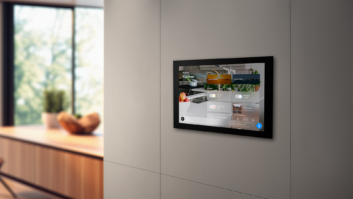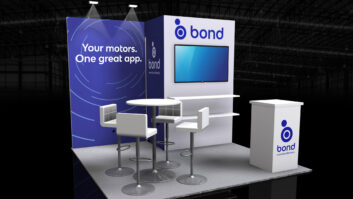The lights were dim as late-arriving attendees scurried to find their seats before the auditorium was plunged into total darkness for the beginning of the keynote presentation. The low murmur of the gathering crowd seemed to gently swell as more entered the space. But floating question marks hung heavy in the air, revealing the attendees’ mood as one more of curiosity than anticipation. They only knew that it was a presentation by Amazon, the 800-pound gorilla of online retailing.
What did Amazon have to do with CEDIA?
The enthusiastic Amazon executive Charlie Kindel easily scaled the three steps to the large platform stage, around which the gathered audience was arrayed in a full 360-degree seating plan. Kindel was there to tell all of CEDIA’s integrators, manufacturers, and others that Amazon wants to work with them on adding a voice user interface (VUI) to their installations. This process is greatly enhanced by the fact that the company has launched products with integrated voice control for as little as $49 (Echo Dot) to as much as $179 (Echo), bringing affordable voice control to the home.

Control4 works hard to be at the forefront of all trends, which is why, when Amazon quietly began opening up the Alexa platform to developers, Control4 engineers began experimenting with it.
But perhaps even more surprising is that the keynote attendees were learning that Amazon had set up “integration partnerships” with a surprisingly large array of companies, including key control brands like Lutron, Crestron, and Control4. These companies, and others, we learned, were demonstrating the integration of voice control into their systems on that very show floor. And bam! Just like that, CEDIA 2016 became “the Voice Control Show.”
But just what did this mean for integrators? What is their reaction to the concept of adding a voice interface to their projects?
Based on conversations with multiple manufacturers with differing levels of commitment to the integration of a voice user interface in their systems, most showed little reserve and seemed quite bullish on the topic. Some are strongly encouraging integrators to quickly hop on the VUI jet, which they suggest is taking off.
In discussions with dozens of home tech pros, there seem to be two distinct camps of opinion when it comes to VUI. The first group seems quite enthusiastic about integrating voice control into installations and is actively taking steps to do so as soon as possible. The second, much larger group–perhaps as much as two-thirds– were excited about the concept of adding a voice control interface but were planning on a much more cautious approach.
Voice Control Origins
If you ask people where the concept of using the human voice to control computers and electronic systems was first suggested, most will typically say from the popular 1960s-era TV show, Star Trek. Even Amazon’s Kindel said the company’s goal in designing the Echo was, “To create a Star Trek computer for the home.” On Star Trek, which premiered in 1966, space explorers traveled the galaxy on a space ship called the Enterprise and interacted with their computer by voice command.
Although voice recognition has been studied in various scientific labs since the 1930s, the first large-scale public introduction to the concept took place on September 23, 1962, when the animated TV series, The Jetsons, debuted on prime time network TV. The Jetsons had a robot maid called Rosie, who followed instructions given to it by voice. This 1962 show predicted many technologies years before they were ever imagined, including flat screen 3D televisions, the use of tablet computers to read the news, computer viruses, video chat (like Skype or Face Time), robotic vacuum cleaners (like the iRobot Roomba), and more.
Voice control of Rosie the Robot and other devices on The Jetsons was featured so prevalently that it normalized the concept. The reality of voice integration in the real world, however, was not so easy and is only now showing promise as a potential system interface.
For the first practical implementation of voice control, skip ahead to the smartphone age, but not as recent as you may remember.
“Voice Control has been around for 20-plus years,” said Savant’s director of product marketing, Tim McInerney. “That’s when I began playing around with [voice recognition software] Dragon Naturally Speaking.”
At first, Dragon Naturally Speaking seemed innovative, converting words spoken into a microphone into text on your screen. But after a while, it grew tedious as it often made several mistakes requiring manual correction. McInerney noted that it has only been recently–very recently– that the accuracy of voice recognition has improved to the point that people can use it regularly without getting frustrated.
Current Channel Options
Savant was not one of the companies at CEDIA 2016 that announced integration with Amazon’s Alexa. But the company counts itself as an early adopter of the concept of voice control, as it included voice technology (neither Amazon- or Google-based) into its popular Savant Remote product. Yes, other remotes over the years have tried to include voice control–but Savant’s solution is savvier and, as some of the integrators who support their brand told us, works fairly well.

With Savant’s remote, homeowners can very easily create scenes with multiple actions that they then save and name. Then, with a simple voice command (or push of a button if you prefer), the remote executes all the elements of the scene instantly.
As McInerney explained, Amazon Alexa and Google Home are both cloud-based services. The signal travels from your control system, to Amazon’s or Google’s servers and a responding signal is sent back to your system. This arrangement causes latency. But in Savant’s case, the process takes place entirely within the hardware, yielding almost zero latency for instant response.
With Savant’s remote, homeowners can very easily create scenes with multiple actions that they then save and name. Then, with a simple voice command (or push of a button if you prefer), the remote executes all the elements of the scene instantly.
“The response from our dealers has been overwhelmingly positive,” McInerney said. “It is our highest selling model in the shortest amount of time.”
Going forward, Savant is carefully testing the Amazon Alexa system, as well as Google Home, Siri, and other systems.
“Yes, I think voice control is the next big thing in user interface,” McInerney said. “I think voice is an amazing user interface. But, I don’t think we’re there just now,” he added, suggesting that the cloud-based solutions aren’t quite yet ready with reliable, repeatable performance.
In contrast to Savant, Control4 is openly enthusiastic about the advent of VUI, particularly in partnership with Amazon Alexa.
“We’re really excited about it,” said Brad Hintze, Control4’s senior director of product marketing. “We think it’s really big for the industry.”
Control4 works hard to be at the forefront of all trends, which is why, when Amazon quietly began opening up the Alexa platform to developers, Control4 engineers began experimenting with it. “We try to be in the front of the trends and oftentimes that means scratching our own nerdy itch,” Hintze said. “The Echo was immediately popular, and our engineers and some of our executives [like] VP products Eric Anderson and I, we got an Echo, and we saw the potential right away. We’ve always had the philosophical approach to home automation that to be successful, you have to support the best devices, whether they come from Control4, or from some third party.”

In discussions with dozens of home tech pros, there seem to be two distinct camps of opinion when it comes to VUI through products such as Amazon Alexa.
Hintze said that when developing for the Alexa platform, there are two paths for potential partners to take: custom skills and smart home skills. Skills are like apps for Alexa that define the command phrase and set the action that a phrase triggers. When Control4 engineers first began experimenting with the system a little over a year ago, they created a custom skill but decided not to publish it. The custom skill path, according to Hintze, “can be quite clunky when you’re interacting with your home.” The reason for this is when developers create custom skills, the end user has to identify that as part of the command. For instance, a command for a custom skill might be something like, “Alexa, tell Control4 to set the dining room lights at 50 percent.” In the opinion of the folks at Control4, adding the words “…tell Control4 to…” to the command was clunky, and not a natural expression for end users.
Then Amazon released a second development path, called smart home skills, which are a set of commands that are native to the system; you don’t have to add any qualifiers. So that same custom command would now simply be, “Alexa, set the dining room lights at 50 percent.” In the opinion of the Control4 team, “that’s a far more intuitive experience.”
“At Control4, we have to consider the entire household, not just the nerd that loves home automation,” Hintze said. “We have to make a natural experience for everyone who’s living in the home… And the easier and more natural we can make it, the more likely everyone is to actually use it.” So Control4 has designed its Alexa integration completely around Amazon’s smart home skills for simpler, more intuitive operation.
And just what is the response from customers so far to their integration with Amazon? “We have over 3,000 homes that are running Amazon Alexa today,” Hintze said. “Which, [considering that] we only launched at CEDIA, that’s a pretty impressive number.”
At CEDIA 2016, when Amazon’s Kindel announced its integration partners during the keynote presentation, he invited one of them, John Clancy of Creston, to the stage to introduce their integration plan. Clancy is Crestron’s VP for the residential channel and is a very vocal proponent of integrators adding a VUI to their installations. As far as he’s concerned, end users are coming to expect it these days.
“Yes, there is a demand and people are excited about it,” Clancy said in regard to their dealers’ reaction to voice control. “But one of the questions I hear a lot is, ‘Well, how do I monetize that… how can I charge for this?’ I try and change the discussion or at least change their mindset in the sense that it’s not about that; it’s about these are expectations that many end users have these days. What we’re trying to do is give you the tools and the ability to do that in the most expansive and yet easiest way possible.”
In designing their integration with Amazon Alexa, Clancy noted that Creston is using both smart home skills and custom skills.
“We do [use both types of skills], but the problem with the smart home skills is they’re finite. There’s only, I think, about 22 smart home skills available,” Clancy said. “And we do utilize those, but we really thought it was important to go beyond that. That’s where the custom skills come in to play.”
Clancy admits that it is a bit clunky for the end user to have to say “… tell Crestron to…” as part of their command. However, the company said it offsets that with wording after those that make the command more intuitive.
“We submitted a list of potential room names [to Amazon for certification] beyond just the living room and dining room and kitchen,” Clancy said. “We’re talking about Billy’s room and Joey’s room and Bobby’s room. And then Bobby’s bedroom”–so there’s different names for the same room, such that each homeowner can say the command in a way that feels most natural to them.
“These lists are significant, so the fact that I can say, ‘Alexa, tell Crestron to turn the lights off in Billy’s room’ goes beyond what the standard smart home skills can provide for,” Clancy added.
Right now Crestron has around 100 test installations involving its VUI integration with Alexa, which Clancy said have gone very well. By the time you read this, it will have opened the system up for sales to its entire dealer base.
Clancy also said that Crestron announced a technical training session in early November for dealers in the New York metro market on how to sell and program both the Amazon Alexa integration, as well as their integration program with Sonos. More than 175 people showed up from more than 90 area dealers.
Excited but Cautious
There is definitely a cadre of enthusiastic, bleedingedge home tech pros ready to pull the trigger and begin immediately implementing the installation of a voice user interface in all of their projects, but many more who preached a more cautious enthusiasm.
As one integrator said, his clients expect three things from his installations: reliability, repeatability, and ease of use. But while Amazon has dramatically improved voice technology, it is not yet perfected in the eyes of many integrators.
Even Clancy admitted, “It’s not perfect and there are some things to be leery of.” Still, he and the other manufacturers seem to feel it will become a staple of system installations going forward.
“It’s exciting, I mean for anybody our age– this is the real Jetsons,” said Franklin Karp, chief operating officer of Audio Video Systems in Plainview, NY. “It’s so nascent. The problem is that it’s such a compelling technology, that the end user is going to force people to integrate [a voice user interface], and it may not truly be ready. And my guess is it’s not truly ready.”
The hesitation that Karp expressed about voice technology being almost–but not quite–ready for prime time is one objection repeated over and over again.
“I think from a really big-picture standpoint, that voice control will be a very significant user interface tool for integrators and for homeowners in the future,” said Mark Hoffenberg, co-founder of Audiovisions in Lake Forest, CA. “It will become increasingly more important the further out we move from today. We are in the infancy of it, and I think it’s pretty exciting. It’s still not a perfected technology, but I believe it will improve rapidly.”
And Karp, for one, doesn’t see the technology going away. “It’s going to be improved. It’s going to be enhanced,” he said. “But is it ready for prime time today? I’m dubious.”
So what’s a home tech pro to do? Most say that they already offer multiple user interfaces–wall pad, touchpanel, remote control–in their projects. After a period of testing and assessment, they will consider adding VUI as yet another interface for inclusion. This strategy, by the way, is one that many manufacturers agree with; they are not planning to discontinue the manufacturing of their other interfaces anytime soon.
One integrator said that he installs concentric rings of control in every installation, both to offer all home occupants a style of control they prefer, and because different forms of control are more appropriate in different situations.
Hoffenberg summarized the home tech pro perspective by saying: “I would caution integrators from making [voice control] the only UI choice.”
A regular RS contributor, Ted Green publishes a widely read weekly CE business blog at Strata-gee.com, the online home of The Stratecon Group, his marketing and strategy agency for the tech industry.







